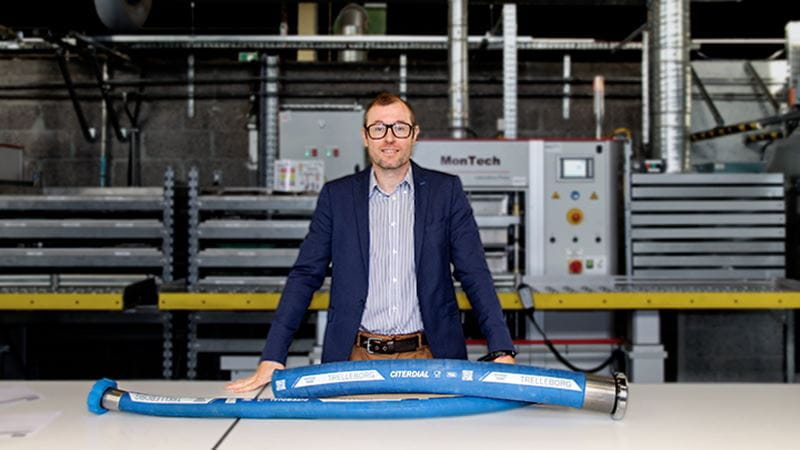Transfer target

Hoses may appear to be just long rubber cylinders, but beneath their plain outer coats are complex layers specifically engineered to make sure that beverages are safe and perfect to drink. Whether for fine cognac or fresh milk, hoses are critical to the transfer of fluids into, out of and around processing systems.
“Basic food and beverage hoses have three layers, with the most complex consisting of as many as 10 layers,” says Gerald Soulagnet, Material Development Manager for Trelleborg’s fluid handling solutions. “There is an inner layer that is in contact with the transfer media and an outer layer exposed to the external environment.”
The inner layer, or tube, must be compatible with media going through hoses to avoid contamination and ensure organoleptic (odor and flavor) neutrality. Laboratory protocols monitor molecule release to select the best raw materials as well as process conditions.
The outer layer, or cover, needs to be robust, hard wearing, able to withstand weather conditions and resist oxidation. In some instances, the layer must ensure low friction for easy movement in food processing facilities and wineries.
“In between the tube and cover lie other layers of reinforcement, and these additional layers have various jobs to do,” Soulagnet explains. “They may give added pressure resistance or more flexibility and bendability. In certain applications, trucks may drive over hoses, and a strengthening layer can prevent the hose from collapsing. In other cases, we may want to add a functional barrier, for example, if there was diffusion of liquid inside the hose structure, we want to limit it to a certain thickness within the hose.”
Any new hose development dedicated to food and beverages must follow strict regulations.
“Today, we see an increase in legal requirements globally,” says Soulagnet. “Previously legislation for food and beverage production primarily came from Europe and America.” Now all countries on all continents are issuing their own standards and requirements.
“We want to provide the safest product wherever it is used,” he says. “That means integrating all requirements together, meeting them and exceeding them to futureproof our hoses.”
Rather than having specific hose ranges for each country, Trelleborg’s strategy is to offer the market one range of hoses that meets the legislation and standards in all countries.
“If we can meet the European regulations, we can achieve the universality in hose specification that we seek,” says Soulagnet. “As long as we have well-positioned products, it makes our life easier when it comes to addressing our product to other markets. Just like us, if customers are global, they don’t want to produce different beverage processing equipment for different markets.”
Would over-specifying hoses for markets that have less demanding regulations increase costs in those markets? In Soulagnet’s view, the benefits of universality significantly outweigh any savings that could potentially be made from offering market-specific hoses.
“Standardization means reduction of our product range, which leads to simplifying and optimizing production planning and supply chain,” he says. “This applies not only to us but to our customers too.” Another consideration is that certification is costly and doing mass certification for all standards at one time for one product is cost-effective.
“Legislation is moving all the time, and those countries with lower specifications will eventually reach the same levels as those countries with the highest specifications,” Soulagnet points out. “After all, milk is milk wherever it is produced in the world, and ultimately the same regulations will be needed everywhere.”
In addition, sustainability is becoming increasingly important, both for Trelleborg’s customers and for the company itself. “We are now capable of developing material formulations for our hoses that include 80 percent natural ingredients and that are from renewable sources,” he says. “For other materials, using them as they come from their source means that we are not using energy in modifying them. In addition, by focusing on the sustainability of production methods for our hose materials, we are reducing CO2 emissions and energy consumption.”
In the future, Soulagnet sees customers expecting more than just hoses. They are demanding related services too. “Trelleborg is not just a global manufacturer of hoses but a solution provider,” Soulagnet says. “For instance, we offer assembly of hoses to a large range of couplings so hoses are ready to use on delivery.We have also developed an effective distribution network and our own service center to support customers.”
Recently approved is the construction of a cleanroom at the Trelleborg service center in Lyon, France, to fulfill the “ready to use” aspect of Trelleborg hoses. “Food producers have certain cleaning protocols they need to follow after receipt of hoses and before first use for food transfer,” says Soulagnet. “Our cleanroom solution will mean that we deliver clean, 100 percent traceable and certified hoses. This provides savings to the food producer by eliminating the initial cleaning step for the customer.”
This is an article has been reproduced from Trelleborg's T-Time magazine. To download the latest edition, go to: www.trelleborg.com/t-time